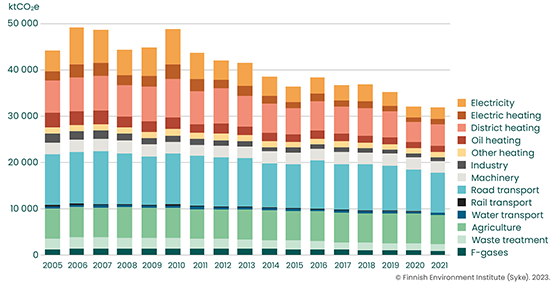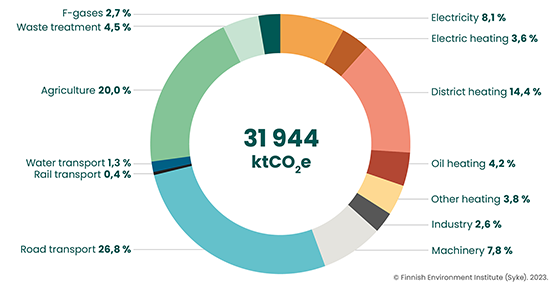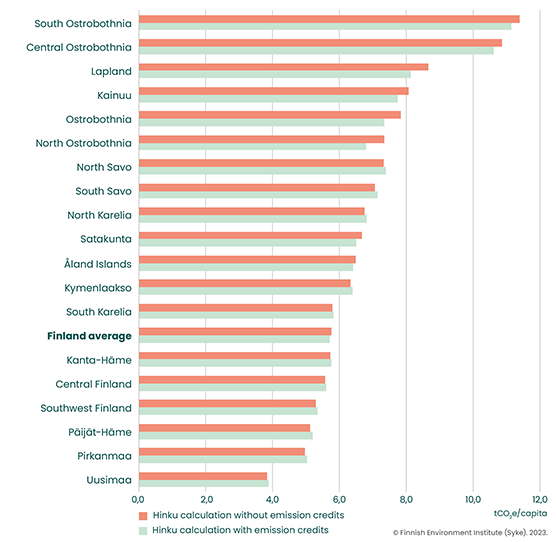Finnish Environment Institute, press release 5/30/2023
According to the Finnish Environment Institute (Syke), municipalities’ total greenhouse gas emissions in 2021 remained at the previous year’s level. Although the transition towards low-carbon solutions in heating methods continued, the positive emissions development was slowed down especially by the higher consumption of heating energy in buildings when compared to the previous year.

The greenhouse gas emissions of Finnish municipalities by sector in 2005–2021. The emissions have been calculated in accordance with the Hinku calculation rules, without carbon offsets. © Finnish Environment Institute
The greatest emission reductions were achieved in road transport, where the development has been driven by the increase in the bio share of liquid transport fuels (petrol and diesel). The total mileage also decreased slightly from the previous year.
Greenhouse gas emissions from district heat production increased by roughly five per cent, whereas energy consumption increased by 15 per cent. Emissions from district heat production per energy produced decreased by around 9 per cent.
The amount of electricity consumed increased by 8 per cent from the previous year, which meant that more fossil fuels had to be used in electricity production. Thus, the specific emission factor of electricity production also increased slightly from the previous year.
“2020 was exceptional, as the global pandemic stopped some of the normal functions of society, but the year was also very warm. Compared to the previous year, 2021 was clearly colder, and society had already begun to recover from the initial shock brought on by the pandemic,” says Santtu Karhinen, Senior Research Scientist at the Finnish Environment Institute, who is responsible for the calculations.
Emissions from waste treatment decreased by 5.4 per cent from the previous year, and the waste sector accounted for 4.5 per cent of total emissions in 2021. Emissions from waste treatment have decreased especially as a result of the recovery of landfill gas and limiting the landfilling of biodegradable waste.
Compared to the previous year, fluorinated greenhouse gas (F-gas) emissions decreased by 7 per cent and emissions from agriculture by slightly over 1 per cent.
The distribution of emissions between different sectors remained relatively unchanged from the previous year. The results from 2021 show that the main emission sectors, to which considerable emissions reduction measures should also be targeted, are road transport (27%), agriculture (20%), district heat consumption (14%) and electricity consumption (heating and consumer electricity totalling 12%).

Distribution of total greenhouse gas emissions of Finnish municipalities in 2021. The emissions have been calculated in accordance with the Hinku calculation rules, without carbon offsets. © Finnish Environment Institute
However, positive emissions trends can be observed over a longer period of time. In 2005–2021, greenhouse gas emission decreased in almost all Finnish municipalities, by 27.7 per cent in total.
Emissions monitoring in the Climate Act
The Climate Act reform provides that a municipality must, at least once per council term, prepare or update a climate plan, which must include, among other things, information on the development of greenhouse gas emissions in the municipality. In accordance with the Climate Act, the Finnish Environment Institute maintains an emissions data service for municipalities and regions.
In the plans devised according to the requirements of the Climate Act, adherence to the limitations of the Hinku calculation rules implemented by the Finnish Environment Institute is advised, excluding carbon offsets. For this reason, the emissions data service maintained by the Finnish Environment Institute will, in the future, present emissions in accordance with the Hinku calculation rules without carbon offsets as the default for emissions monitoring. The general reporting and communications regarding the results will also include the monitoring of emissions data in accordance with the requirements of the legislation.
“In order to monitor the ambitious emissions reduction targets of the Hinku network municipalities, the emissions data service will also continue to present emissions in accordance with the Hinku calculation rules, including carbon offsets, in accordance with the previously agreed offsetting practices of the Hinku network. The results are available in the emissions information service without the limitations of the Hinku calculation rules, in addition to which the emissions data are available as differentiated for the effort sharing sector and emissions trading,” says Karhinen.
Differences in emissions per capita between regions
There are still considerable differences between municipalities and regions in the sectoral distribution of emissions and their development. As in the previous years, emissions per capita are lowest in the southern regions. However, relatively, emissions per capita decreased most in the northern regions of Lapland, North Ostrobothnia and Kainuu.
The regional differences are explained by factors such as differences in the economic structure (e.g. agriculture-dominated regions), geography (distances and community structure), weather conditions and fuel use in district heating.

Greenhouse gas emissions calculated per capita in Finnish regions in 2021. The emissions have been calculated in accordance with the Hinku calculation rules. © Finnish Environment Institute Syke
Emissions calculation is developing
A few changes were made to the newly published emissions calculations, which, in addition to the results for 2021, also affected the previously published emissions time series. The characterisation factors used in the aggregation of the global warming potential (GWP) of different greenhouse gases were updated as the coefficients of the national greenhouse gas inventory changed. This change had an impact especially on the emissions results for waste treatment, agriculture and F-gases.
Industrial emissions calculation was modified so that the emissions of all emissions trading industries were excluded from the Hinku calculations regardless of gas. Methane and nitrous oxide emissions caused by the emissions trading industry belonging to the effort sharing sector had previously been included in Hinku emissions, which significantly increased the industrial emissions monitored in Hinku calculations in some municipalities.
In waste treatment emissions, wastewater calculation was specified by taking better into account the source of the wastewater and its treatment methods. The new approach distinguishes between emissions from centralised and decentralised wastewater treatment, which are divided for municipalities on the basis of the population numbers in their agglomerations and sparsely populated areas.
In road transport calculations, the emission factors related to street and road network mileage were specified, which also had an impact on the total emissions of road transport in municipalities.
Next, the emissions information service will be expanded to also include emissions data from 1990, as some municipalities have chosen it as the reference year for their emissions targets in their climate work. In autumn 2023, preliminary data on emissions for 2022 will be published, which will be finalised in spring 2024.
The municipal emissions calculation system has received funding from the Life IP Canemure project of the European Union.
Emissions calculation materials are publicly available:
Graphs
Further information
Santtu Karhinen, Senior Research Scientist, Finnish Environment Institute, tel. +358 29 525 1889, firstname.lastname@syke.fi
Eija Ferreira, Senior Research Scientist (Oil and other separate heating), Finnish Environment Institute, tel. +358 29 525 227, firstname.lastname@syke.fi
Juha Grönroos, Senior Research Scientist (Agriculture), Finnish Environment Institute, tel. +358 29 525 1128, firstname.lastname@syke.fi
Tommi Forsberg, Coordinator (F-gases), Finnish Environment Institute, tel. +358 29 525 1116, firstname.lastname@syke.fi
Jouko Petäjä, Senior Research Scientist (Landfills), Finnish Environment Institute, puh. +358 29 525 1508, firstname.lastname@syke.fi
Professor Jyri Seppälä, National Director of the Hinku network, Finnish Environment Institute, tel. +358 29 525 1629, firstname.lastname@syke.fi